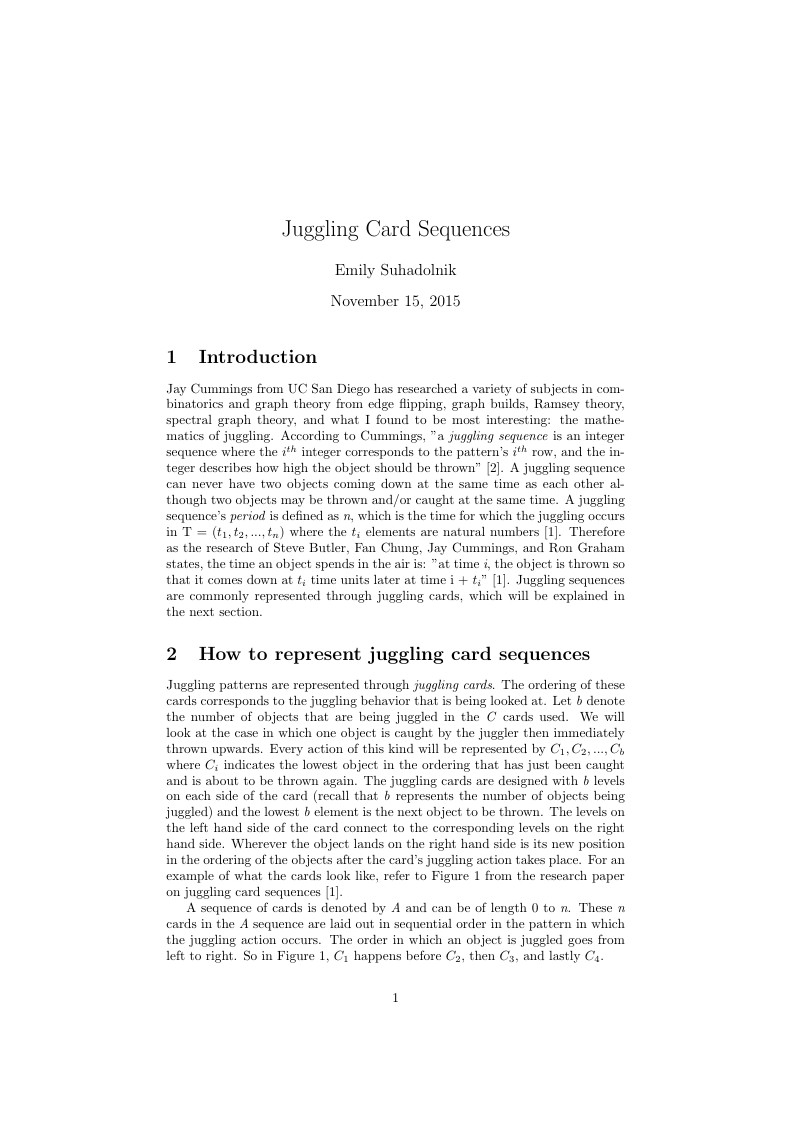
Juggling Card Sequences
Autor:
esuhadolnik
Last Updated:
hace 10 años
License:
Creative Commons CC BY 4.0
Resumen:
Math project.

\begin
Discover why over 20 million people worldwide trust Overleaf with their work.

\begin
Discover why over 20 million people worldwide trust Overleaf with their work.
\documentclass[a4paper]{article}
\usepackage[english]{babel}
\usepackage[utf8x]{inputenc}
\usepackage{amsmath}
\usepackage{graphicx}
\usepackage[colorinlistoftodos]{todonotes}
\title{Juggling Card Sequences}
\author{Emily Suhadolnik}
\begin{document}
\maketitle
\section{Introduction}
Jay Cummings from UC San Diego has researched a variety of subjects in combinatorics and graph theory from edge flipping, graph builds, Ramsey theory, spectral graph theory, and what I found to be most interesting: the mathematics of juggling. According to Cummings, "a \textit{juggling sequence} is an integer sequence where the $i^{th}$ integer corresponds to the pattern's $i^{th}$ row, and the integer describes how high the object should be thrown" [2]. A juggling sequence can never have two objects coming down at the same time as each other although two objects may be thrown and/or caught at the same time. A juggling sequence's \textit{period} is defined as \textit{n}, which is the time for which the juggling occurs in T = ($t_1, t_2, ..., t_n$) where the $t_i$ elements are natural numbers [1]. Therefore as the research of Steve Butler, Fan Chung, Jay Cummings, and Ron Graham states, the time an object spends in the air is: "at time \textit{i}, the object is thrown so that it comes down at $t_i$ time units later at time i + $t_i$" [1]. Juggling sequences are commonly represented through juggling cards, which will be explained in the next section.
\section{How to represent juggling card sequences}
Juggling patterns are represented through \textit{juggling cards}. The ordering of these cards corresponds to the juggling behavior that is being looked at. Let \textit{b} denote the number of objects that are being juggled in the \textit{C} cards used. We will look at the case in which one object is caught by the juggler then immediately thrown upwards. Every action of this kind will be represented by \textit{$C_1, C_2, ..., C_b$} where \textit{$C_i$} indicates the lowest object in the ordering that has just been caught and is about to be thrown again. The juggling cards are designed with \textit{b} levels on each side of the card (recall that \textit{b} represents the number of objects being juggled) and the lowest \textit{b} element is the next object to be thrown. The levels on the left hand side of the card connect to the corresponding levels on the right hand side. Wherever the object lands on the right hand side is its new position in the ordering of the objects after the card's juggling action takes place. For an example of what the cards look like, refer to Figure 1 from the research paper on juggling card sequences [1].
\begin{figure}
\centering
\includegraphics[width=1.0\textwidth]{cards.png}
\caption{\label{Figure 1 :} Cards for \textit{b} = 4 [1]}
\end{figure}
A sequence of cards is denoted by \textit{A} and can be of length 0 to \textit{n}. These \textit{n} cards in the \textit{A} sequence are laid out in sequential order in the pattern in which the juggling action occurs. The order in which an object is juggled goes from left to right. So in Figure 1, $C_1$ happens before $C_2$, then $C_3$, and lastly $C_4$.
If we wanted to increase the number of objects that are caught and thrown at the same time as each other we symbolize the card sequence as $C_s$ where \textit{S} = ($s_1, s_2, ..., s_k$) in a ordered subset of [\textit{b}]. In this case the cards are laid out the same, but the two objects being thrown and caught at the same time are represented by \textit{$C_{x,y}$} where \textit{x} is the first object and \textit{y} is the second to be thrown. Remember that although these objects can be thrown and caught at the same time, they can never be falling at the exact same time as each other.
Overall, these juggling card sequence figures are helpful in representing what is occurring in the juggling act. We can also look at the end action of a card and determine which object was thrown at the beginning of the card's turn. This is possible by \textit{Proposition 1} found in the research paper of Butler, Chung, Cummings, and Graham where the proposition declares that once we know the ordering of the objects on the right hand side of the card we can determine which one was thrown at the beginning of the card's turn because the objects on the left hand side had to once begin in sequential order [1].
After reading their research, I found that the case in which one object is thrown and then caught most efficiently summed up what a juggling sequence is and how it can be represented through juggling sequence cards. However, if you are further interested in this topic, the rest of the paper introduces various other topics and scenarios of juggling and card sequences. For example the paper addresses what would happen if we threw different numbers of objects at different times, how to preserve the order of the objects during the throwing action, how we can determine the number of objects that the object being thrown crosses before being caught, and so on.
\begin{thebibliography}{9}
\bibitem{latexcompanion}
Steve Butler, Fan Chung, Jay Cummings, Ron Graham.
\textit{Juggling Card Sequences}.
Sequences." ArXiv. ArXiv, 6 Apr. 2015. Web. 15 Nov. 2015.
\bibitem{latexcompanion}
Jay Cummings.
\textit{Research Statement}.
UC San Diego Math. UC San Diego, n.d. Web. 15 Nov. 2015.
\end{thebibliography}
\end{document}